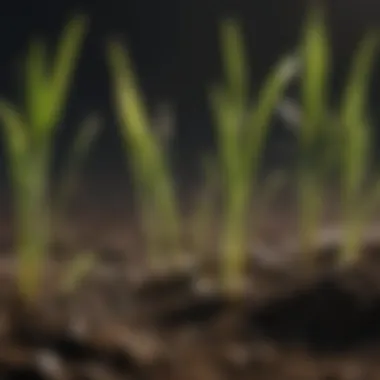Discover the Optimal Time to Sow Grass Seed for a Luxuriant Lawn


Gardening Expertise
Seasonal Considerations and Grass Seed Germination
The process of planting grass seed is highly dependent on the prevailing weather conditions and seasonal fluctuations. Spring and fall are widely regarded as the most favorable periods for planting grass seed, as the soil temperature and moisture levels are conducive to germination. During these seasons, grass seed can establish strong root systems and thrive in preparation for the harsher conditions of summer or winter. Understanding the unique requirements of different grass varieties and selecting the optimal time based on local climate patterns are crucial steps in ensuring a successful lawn establishment.
Choosing the Right Grass Seed for Your Lawn
Selecting the appropriate grass seed is a critical aspect of achieving a lush and vibrant lawn. Factors such as sunlight exposure, soil type, and expected foot traffic should be taken into account when choosing a grass seed variety. Cool-season grasses like Kentucky bluegrass or fescue are well-suited for northern regions with cold winters, while warm-season grasses such as Bermuda grass or Zoysia grass thrive in southern climates with hot summers. By considering these factors and selecting a grass seed variety that aligns with your lawn's unique requirements, you can lay the foundation for a healthy and resilient turf.
Preparing the Soil and Planting Grass Seed
Proper soil preparation is essential for the successful germination and growth of grass seed. Begin by clearing the area of debris and weeds, ensuring a clean and suitable surface for planting. Loosen the soil to a depth of a few inches to improve aeration and drainage, promoting healthy root development. After preparing the soil, evenly distribute the grass seed using a broadcast spreader to achieve uniform coverage. Lightly rake the soil to ensure good seed-to-soil contact, aiding in germination. Water the newly planted grass seed regularly to maintain consistent moisture levels, facilitating sprouting and root establishment.
Maintenance and Care for a Lush Lawn
Once the grass seed has germinated and established, ongoing maintenance is crucial for nurturing a lush and thriving lawn. Regular mowing, watering, and fertilization are essential practices to ensure the continued health and vigor of the turf. Monitor the lawn for signs of stress or disease and address issues promptly to prevent extensive damage. By providing proper care and attention to your lawn, you can enjoy a luxurious and verdant outdoor space that enhances the beauty of your home.
Conclusion
Understanding Grass Seed Planting
In the realm of cultivating a vibrant lawn, understanding the nuances of grass seed planting emerges as a pivotal discourse. Homeowners aspire to create lush outdoor spaces that breathe life and vibrancy into their surroundings, making the process of planting grass seed a judicious undertaking. This article endeavors to shed light on the essential elements encompassing grass seed planting, delving into its significance, benefits, and meticulous considerations for achieving a verdant turf.
Factors Affecting Grass Seed Germination
Soil Temperature
One of the cardinal determinants influencing grass seed germination is the soil temperature. This fundamental aspect plays a definitive role in the successful sprouting and growth of grass seeds. The optimal soil temperature fosters an environment conducive to seed development, ensuring a robust foundation for a flourishing lawn. Embracing the right soil temperature sets the stage for accelerated germination rates and robust root establishment, fortifying the lawn's resilience against adversities.
Moisture Levels
Moisture levels stand as a critical factor shaping the germination process of grass seeds. Adequate moisture content within the soil matrix is indispensable for triggering the initiation of germination, fostering hydration and nourishment essential for seedling growth. However, an excess of moisture can impede germination, leading to challenges such as fungal diseases and root rot. Striking a delicate balance in moisture levels is imperative to nurture the seeds towards healthy maturation, ensuring a flourishing lawn.
Light Exposure
Light exposure constitutes another pivotal facet influencing the germination dynamics of grass seeds. Appropriate access to sunlight is vital for photosynthetic processes fundamental to plant growth and development. However, excessive exposure to intense sunlight can exert detrimental effects, leading to heat stress and scorching. Strategically managing light exposure by providing optimal conditions fosters robust photosynthesis, propelling the seedlings towards strong, vigorous growth.
Types of Grass Seed
Cool-Season Grasses
Cool-season grasses exemplify a category of turf varieties adept at thriving in cooler climatic conditions. Their inherent resilience to frost and ability to maintain verdant foliage during colder months render them a favorable choice for homeowners seeking lush lawns. The key characteristic of cool-season grasses lies in their capacity to endure low temperatures while sustaining visual appeal, making them a popular selection for regions experiencing chilly winters.


Warm-Season Grasses
Conversely, warm-season grasses epitomize a distinct class of turfgrasses tailored for flourishing in warmer environments. With an intrinsic affinity for heat and sunlight, warm-season grasses exhibit heightened growth rates during the summer months. Their resilience to scorching temperatures and capacity for thriving in arid conditions position them as sought-after options for homeowners residing in regions characterized by intense heat.
Mixed Grass Seed Blends
Mixed grass seed blends present a harmonious amalgamation of various grass species, offering a versatile and resilient lawn solution. These blends bestow a diverse range of qualities, amalgamating the strengths of different grass types to form a comprehensive turf foundation. The unique feature of mixed grass seed blends lies in their ability to cater to multifaceted lawn requirements, encompassing traits from different grass varieties to optimize visual appeal, resilience, and adaptability. Whether seeking a blend for varied climatic conditions or desiring an aesthetically pleasing lawn, mixed grass seed blends emerge as a strategic choice for homeowners seeking a tailored turf solution.
Ideal Timing for Planting Grass Seed
When contemplating the ideal timing for planting grass seed, homeowners are embarking on a critical journey towards cultivating a lush and vibrant lawn. This section serves as the cornerstone of this comprehensive guide, shedding light on the significance of selecting the right moment to sow grass seed. Understanding the seasonal nuances and environmental conditions that influence seed germination is paramount in ensuring the successful establishment of a healthy lawn ecosystem. By exploring the benefits and considerations associated with ideal timing for planting grass seed, individuals can elevate their outdoor spaces to new levels of aesthetic appeal and functionality.
Early Spring Planting
Benefits: The early spring planting period offers a myriad of advantages for those looking to rejuvenate their lawn. The cooler temperatures and increased moisture levels during this time create optimal conditions for seed germination and root growth. This results in faster establishment of grass varieties, enhancing the overall resilience and lushness of the lawn. Additionally, early spring planting allows homeowners to tackle weed control more effectively, setting the stage for a weed-free and healthy lawn.
Considerations: Despite the many benefits, early spring planting also comes with its set of considerations. One key aspect to bear in mind is the potential for late frosts, which can hinder germination and growth. Furthermore, excessive rainfall in some regions may lead to waterlogging, affecting seed viability. Balancing these considerations with the benefits is crucial in making an informed decision on whether early spring planting is the right choice for your lawn.
Late Spring Planting
Advantages: Late spring planting presents unique advantages for homeowners seeking to establish a robust lawn. The warmer temperatures and longer days of late spring facilitate rapid growth and development of grass seedlings, leading to quicker coverage and a denser turf. This period also allows for greater flexibility in seed selection, as warm-season grasses thrive in the escalating temperatures of late spring.
Challenges: Alongside its advantages, late spring planting brings forth certain challenges that necessitate consideration. The increased competition from weeds during this period poses a threat to newly germinated grass seeds. Additionally, the potential for dry spells in some regions may require supplemental watering to support healthy growth. Effectively managing these challenges is essential in maximizing the benefits of late spring planting for a lush and thriving lawn.
Fall Planting
Pros: Fall planting presents a host of benefits for homeowners aiming to establish a resilient and vibrant lawn. The cooler temperatures and ample rainfall of the fall season create optimal conditions for seed germination and root establishment. Grass seedlings that are planted in the fall have the opportunity to develop robust root systems throughout the winter, leading to increased drought resistance and overall hardiness.
Cons: Despite its advantages, fall planting is not without its drawbacks. The shorter days and declining temperatures of fall may slow down the germination process, prolonging the establishment phase of the lawn. Additionally, the presence of fallen leaves and debris can impede seed-to-soil contact, affecting germination rates. Understanding these cons and implementing appropriate strategies is crucial in maximizing the benefits of fall planting for a lush and healthy lawn.
Summer Planting
Risks: Summer planting introduces certain risks that homeowners need to be mindful of when considering seeding their lawn during this season. The high temperatures and intense sunlight of summer can place stress on germinating seeds, leading to reduced viability and potential for sunburn. Additionally, water evaporation rates are higher in summer, requiring frequent and consistent watering to ensure adequate moisture levels for seed germination.
Strategies: Mitigating the risks associated with summer planting involves implementing strategic approaches to optimize seed viability and growth. Utilizing shade cloth or mulch can help regulate soil temperatures and moisture levels, protecting seeds from the harsh summer conditions. Adjusting watering schedules to avoid midday heat and providing supplemental irrigation during dry spells are essential strategies for nurturing healthy grass seedlings during the summer months.
Climate Considerations and Regional Variations
In the context of cultivating a flourishing lawn, understanding the climate considerations and regional variations is paramount. These factors play a crucial role in determining the success of grass seed planting and subsequent growth. By considering the specific climate of your region, you can optimize the timing and methods for seeding your lawn, ensuring that it thrives in its environment.
Northern Regions
Recommended Months
When discussing the ideal timeframe for planting grass seed in Northern regions, certain months stand out as particularly advantageous. The recommended months, typically in early spring and early fall, provide the most conducive conditions for grass seed germination due to milder temperatures and consistent moisture levels. These months offer the best balance of warmth and coolness, creating optimal conditions for strong and healthy grass growth.


Challenges
Despite the benefits of the recommended months for grass seed planting, Northern regions pose certain challenges that must be addressed. With shorter growing seasons and the potential for unexpected frosts, timing becomes critical. Balancing early planting to maximize growth with avoiding late frosts requires careful planning and monitoring to prevent setbacks in the lawn's development.
Southern Regions
Best Timeframes
In Southern regions, the best timeframes for grass seed planting differ from those in the North due to the warmer climate. Late spring and early fall emerge as the prime periods for seeding, allowing the grass to establish before the harsh heat of summer or the cooler temperatures of winter. These timeframes capitalize on the region's extended growing season, promoting robust root development and overall lawn vitality.
Precautions
Despite the favorable timeframes for seeding, Southern regions present specific precautions that homeowners should consider. The intense heat of summer can pose challenges to new grass growth, necessitating additional watering and monitoring to prevent dehydration and sun damage. Furthermore, ensuring adequate soil moisture and protection from excessive sunlight are crucial precautions to safeguard the newly planted grass.
Coastal Areas
Unique Considerations
Coastal areas introduce unique considerations when planting grass seed, influenced by proximity to the sea and saltwater exposure. The salt content in the air and soil can impact the growth of grass, requiring special attention to seed selection and soil preparation. Understanding these coastal influences is key to successfully establishing a lush lawn that thrives despite the coastal environment.
Optimal Planting Period
Determining the optimal planting period in coastal areas involves balancing the salt exposure with favorable growing conditions. Early fall emerges as a preferred time for seeding in coastal regions, allowing the grass to take root before winter while minimizing exposure to summer salt sprays. This period offers a window of opportunity for the grass to establish itself and develop resilience against coastal elements.
Section 4: Preparing Your Lawn for Grass Seed Planting
In the realm of cultivating a flourishing lawn, the crucial foundation lies in preparing the ground meticulously before sowing the grass seed. This preparatory phase sets the stage for the successful germination and growth of the grass, ultimately leading to a lush and vibrant lawn that homeowners desire. The process of preparing the lawn encompasses several essential elements that warrant careful consideration and attention to detail.
Soil Preparation
Aeration Techniques
A key element in soil preparation is the utilization of aeration techniques. Aeration involves perforating the soil with small holes to alleviate compaction and enhance air circulation, water penetration, and nutrient absorption. This procedure aids in fostering a healthy root system for the grass to thrive. The distinctive feature of aeration lies in its ability to rejuvenate the soil structure, promoting optimal conditions for grass seed germination. The benefits of aeration techniques include improved soil drainage, enhanced oxygen flow to the roots, and better absorption of essential nutrients, ultimately creating a conducive environment for robust grass growth.
Soil Testing
Another integral aspect of soil preparation is soil testing, which provides valuable insights into the nutrient composition and p H levels of the soil. Soil testing allows homeowners to ascertain the specific requirements of the soil and determine the necessary amendments for optimal grass growth. The significance of soil testing lies in its ability to identify deficiencies in the soil, enabling targeted fertilization and nutrient enrichment. By analyzing the unique composition of the soil, individuals can tailor their lawn care practices to address specific deficiencies and create an ideal foundation for the successful cultivation of grass seed.
Weed Control
In the pursuit of a healthy and immaculate lawn, effective weed control strategies play a vital role in maintaining the integrity of the grass and preventing invasive plant species from impeding its growth. Weed control encompasses both pre-emergent strategies and post-emergent solutions, each serving distinct purposes in preserving the lushness of the lawn.
Pre-Emergent Strategies


Pre-emergent strategies focus on preventing weed seeds from germinating and establishing themselves in the soil. By applying pre-emergent herbicides at the appropriate time, homeowners can create a barrier that inhibits weed growth, safeguarding the newly sown grass seed from competitive intrusions. The key characteristic of pre-emergent strategies lies in their proactive approach to weed management, addressing weed growth before it becomes a pervasive issue. These strategies offer a preventive measure against weed infestation, maintaining the pristine condition of the lawn.
Post-Emergent Solutions
Contrastingly, post-emergent solutions target existing weeds that have already emerged in the lawn. Post-emergent herbicides are applied directly to the unwanted vegetation, effectively eliminating unsightly weeds and preserving the aesthetic appeal of the grass. The primary advantage of post-emergent solutions is their targeted action, which selectively eradicates weeds without harming the surrounding grass. By promptly addressing weed infestations with post-emergent treatments, homeowners can ensure the unobstructed growth and vitality of the grass seed.
Fertilization Practices
Promoting vigorous growth and lush greenery, fertilization practices are integral to sustaining a healthy lawn ecosystem. The application of fertilizers provides essential nutrients that bolster the development of the grass, enriching the soil for optimal plant vitality. Fertilization practices encompass the choice between organic and synthetic fertilizers, as well as strategic considerations regarding the timing of fertilizer application.
Organic vs. Synthetic Fertilizers
The debate between organic and synthetic fertilizers revolves around the source of nutrients and their long-term impact on soil health. Organic fertilizers, derived from natural sources, offer slow-release nutrients that gradually enrich the soil and promote sustainable growth. In comparison, synthetic fertilizers provide readily available nutrients for immediate uptake by the grass, triggering rapid growth but potentially compromising long-term soil fertility. The unique feature of organic fertilizers lies in their environmentally friendly composition, which enhances soil structure and microbial activity, fostering a balanced ecosystem for the grass to thrive.
Application Timing
The timing of fertilizer application plays a crucial role in maximizing nutrient absorption and minimizing nutrient runoff. Applying fertilizers at the opportune moment ensures that the grass receives the necessary nutrients during its growth stages, promoting strong root development and vibrant foliage. The key characteristic of proper application timing is its strategic alignment with the grass's growth cycles, delivering nutrients when the plants can best utilize them. By adhering to a well-defined schedule for fertilizer application, homeowners can optimize the effectiveness of fertilization practices and nurture a luxuriant lawn environment.
Post-Planting Care and Maintenance
Post-planting care and maintenance play a critical role in ensuring the success of your lawn growth endeavors. It involves nurturing the newly planted grass seeds to establish a healthy lawn. By focusing on proper care and maintenance, homeowners can promote robust growth and a lush, green lawn that enhances the overall appeal of their outdoor space.
Watering Guidelines
Establishment Phase:
The establishment phase is a crucial period that follows the initial planting of grass seeds. During this phase, consistent and adequate watering is essential to facilitate seed germination and root development. Proper hydration promotes strong growth and helps the seeds take root firmly in the soil, setting the foundation for a thriving lawn. Homeowners should ensure that the soil remains consistently moist but not waterlogged to support healthy growth during the establishment phase.
Ongoing Maintenance:
Ongoing maintenance regarding watering is pivotal for the long-term health of your lawn. It involves adhering to a regular watering schedule to sustain optimal moisture levels in the soil. By providing consistent hydration based on the specific needs of the grass type planted, homeowners can prevent issues such as drought stress or waterlogging. Ongoing watering maintenance supports lush growth, strengthens grass resilience, and enhances the overall aesthetics of the lawn.
Mowing Recommendations
Proper Heights:
Maintaining the proper mowing height is essential for promoting the health and vigor of your lawn. Cutting grass at the appropriate height helps develop deeper root systems, enhances drought tolerance, and reduces weed infestation. The proper mowing height varies based on the grass species planted and should be adjusted accordingly to prevent scalping or shading out the grass. Consistently mowing at the correct height contributes to a well-manicured lawn with a uniform appearance.
Frequency:
The frequency of mowing plays a significant role in maintaining a healthy lawn. Regular mowing ensures that grass remains at an optimal height for growth and prevents it from becoming overly long, which can weaken the plants. Mowing at the right frequency helps promote thick, lush turf by encouraging lateral spreading and tillering. However, excessively frequent mowing can stress the grass and impede its ability to recover, impacting overall lawn health.
Monitoring Growth Progress
Signs of Healthy Germination:
Recognizing the signs of healthy germination is vital for evaluating the progress of your lawn growth. These signs may include the emergence of new grass blades, increased density of grass cover, and uniform growth patterns. Observing these indicators signifies successful seed germination and establishes a solid foundation for further lawn development. Understanding the signs of healthy germination allows homeowners to adjust their maintenance practices and address any issues that may arise promptly.
Troubleshooting Issues:
Effective troubleshooting of potential lawn issues is essential for maintaining a vibrant and thriving outdoor space. Identifying challenges such as disease, pests, or nutrient deficiencies early on can prevent significant damage to the lawn. Implementing targeted solutions based on the specific issue encountered can help restore the health and vitality of the grass. By addressing problems promptly and effectively, homeowners can ensure the longevity and beauty of their lawn.







